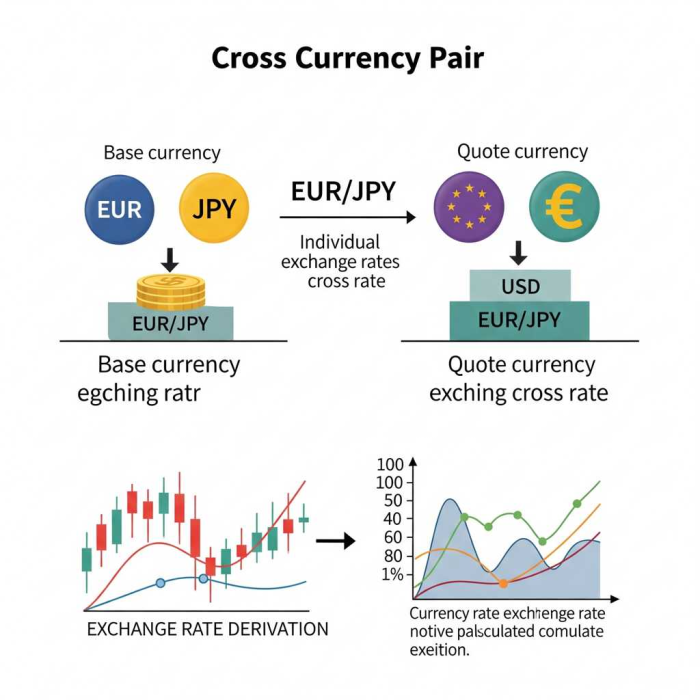Beyond the Dollar | Unpacking Cross Currency Pairs and How Their Rates are Derived
A cross currency pair, often simply called a "cross," is any currency pair that does not include the US Dollar (USD). While the USD is the world's primary reserve currency and involved in the majority of global transactions, many countries conduct significant trade and investment with each other without the need for the greenback as an intermediary. Cross currency pairs facilitate these direct exchanges.

Common examples of cross currency pairs include:
- EUR/JPY (Euro vs. Japanese Yen)
- GBP/JPY (British Pound vs. Japanese Yen)
- EUR/GBP (Euro vs. British Pound)
- AUD/NZD (Australian Dollar vs. New Zealand Dollar)
- CHF/JPY (Swiss Franc vs. Japanese Yen)
Why Do Cross Currency Pairs Exist? (A Historical Perspective)
Historically, if someone in, say, Germany wanted to exchange Euros for Japanese Yen, they would often first have to convert their Euros to US Dollars (EUR/USD), and then convert those US Dollars to Japanese Yen (USD/JPY). This "two-step" process was necessary because direct liquidity between many non-USD currencies was limited in the interbank market.
However, with the growth and technological advancements of the global forex market, direct trading between many currency pairs became common. This not only streamlined transactions but also often reduced costs (as you only cross one spread, not two).
How is the Exchange Rate of a Cross Currency Pair Derived? (The "Triangulation" Method)
Even though you can directly trade cross currency pairs today, their exchange rates are still fundamentally derived from their relationship with the US Dollar. This process is often referred to as triangulation.
Imagine you want to find the exchange rate for EUR/JPY. Your broker, or the interbank market, will use the rates of two major pairs that both involve the USD:
- EUR/USD (Euro vs. US Dollar)
- USD/JPY (US Dollar vs. Japanese Yen)
The calculation works by essentially performing two implied conversions through the USD.
Let's use an example:
Suppose you have the following current rates:
- EUR/USD = 1.0850 (meaning 1 Euro buys 1.0850 US Dollars)
- USD/JPY = 155.20 (meaning 1 US Dollar buys 155.20 Japanese Yen)
To find the EUR/JPY rate, you can think of it this way:
- If you have 1 Euro, it's worth 1.0850 US Dollars.
- Each of those 1.0850 US Dollars can then buy 155.20 Japanese Yen.
So, to get the EUR/JPY rate, you simply multiply the two rates:
$EUR/JPY = EUR/USD \times USD/JPY$
$EUR/JPY = 1.0850 \times 155.20$
$EUR/JPY \approx 168.392$
This means that 1 Euro would buy approximately 168.392 Japanese Yen.
Another Common Scenario: When the USD is the Base Currency in one pair and Quote Currency in another
Consider GBP/CHF. You'd use:
- GBP/USD
- USD/CHF (Note: CHF/USD is also common, which would require inversion)
Let's say:
- GBP/USD = 1.2700
- USD/CHF = 0.9050
$GBP/CHF = GBP/USD \times USD/CHF$
$GBP/CHF = 1.2700 \times 0.9050$
$GBP/CHF \approx 1.14935$
What if the USD is the Quote Currency in both? (E.g., AUD/NZD)
For AUD/NZD, you'd use:
- AUD/USD
- NZD/USD
Let's say:
- AUD/USD = 0.6600
- NZD/USD = 0.6150
To find AUD/NZD, you want to know how many NZD you get for 1 AUD. You divide the AUD/USD rate by the NZD/USD rate:
$AUD/NZD = AUD/USD \div NZD/USD$
$AUD/NZD = 0.6600 \div 0.6150$
$AUD/NZD \approx 1.07317$
The Impact of the USD on Cross Currency Pairs
Even though the USD isn't directly in a cross currency pair, its influence is ever-present due to this triangulation method.
- Indirect Sensitivity: Economic data or news affecting the USD (like Non-Farm Payrolls, Fed interest rate decisions) can still move cross currency pairs. For example, if the USD strengthens significantly, it might indirectly put pressure on both EUR/USD and USD/JPY, affecting their derived EUR/JPY rate.
- Correlation: You'll often see correlations between crosses and their underlying major pairs. If EUR/USD is trending up strongly, and USD/JPY is ranging, EUR/JPY might also trend up, reflecting the Euro's strength against the Dollar.
- Liquidity and Spreads: While major crosses (like EUR/JPY, EUR/GBP) are very liquid, generally, cross currency pairs tend to have slightly lower liquidity and wider spreads compared to major pairs. This is because they involve two "legs" of implied transactions.
Why Trade Cross Currency Pairs?
- Diversification: They offer opportunities to diversify your trading portfolio beyond just USD-centric pairs.
- Unique Dynamics: Crosses can move based on the specific economic or political dynamics between the two countries involved, providing distinct trading opportunities not found in major pairs. For example, EUR/GBP is heavily influenced by UK and Eurozone economic and political developments (like Brexit).
- Carry Trade Opportunities: Many carry trades involve cross currency pairs (e.g., AUD/JPY, NZD/JPY) where traders borrow in a low-interest rate currency (like JPY) and invest in a high-interest rate currency (like AUD or NZD) to profit from the interest rate differential.
In conclusion, cross currency pairs are an essential part of the forex market, allowing direct exchange between non-USD currencies. While they offer unique trading opportunities and diversification, understanding their derivation through triangulation with the USD is key to appreciating their underlying dynamics and effectively managing trades.
Popular Tags